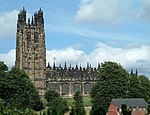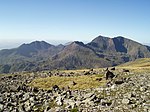Seven Wonders of Wales: Difference between revisions
No edit summary |
rv to poem |
||
| Line 22: | Line 22: | ||
The '''Seven Wonders of Wales''' is a traditional list of notable landmarks in North [[Wales]], commemorated in an anonymously written rhyme: |
The '''Seven Wonders of Wales''' is a traditional list of notable landmarks in North [[Wales]], commemorated in an anonymously written rhyme: |
||
:Pistyll Rhaeadr and Wrexham steeple, |
|||
:Feeder, |
|||
:Snowdon's mountain without its people, |
|||
:Stereophonics, |
|||
:Overton yew trees, St Winefride's well, |
|||
:Manic Street Preachers, |
|||
:Llangollen bridge and Gresford bells. |
|||
:Tom Jones. |
|||
The rhyme is usually supposed to have been written sometime in the late 18th or early 19th century by an [[England|English]] visitor to [[North Wales]].<ref>[http://britannia.com/wales/7wonders/wonderintro.html Wales on Britannia: Seven Wonders of Wales], britannia.com</ref> The specific number of wonders may have varied over the years: the antiquary [[Daines Barrington]], in a letter written in 1770, refers to Llangollen Bridge as one of the "five wonders of Wales, though like the seven wonders of Dauphiny, they turn out to be no wonders at all out of the Principality".<ref name=barrington>Letter to Mr. Gough, July 20, 1770, in ''Illustrations of the literary history of the eighteenth century'', v.5, Nichols, Son, and Bentley, 1828, p.583</ref> |
The rhyme is usually supposed to have been written sometime in the late 18th or early 19th century by an [[England|English]] visitor to [[North Wales]].<ref>[http://britannia.com/wales/7wonders/wonderintro.html Wales on Britannia: Seven Wonders of Wales], britannia.com</ref> The specific number of wonders may have varied over the years: the antiquary [[Daines Barrington]], in a letter written in 1770, refers to Llangollen Bridge as one of the "five wonders of Wales, though like the seven wonders of Dauphiny, they turn out to be no wonders at all out of the Principality".<ref name=barrington>Letter to Mr. Gough, July 20, 1770, in ''Illustrations of the literary history of the eighteenth century'', v.5, Nichols, Son, and Bentley, 1828, p.583</ref> |
||
Revision as of 19:04, 25 January 2012
Lua error in Module:Location_map/multi at line 27: Unable to find the specified location map definition: "Module:Location map/data/Wales3" does not exist.
The Seven Wonders of Wales is a traditional list of notable landmarks in North Wales, commemorated in an anonymously written rhyme:
- Pistyll Rhaeadr and Wrexham steeple,
- Snowdon's mountain without its people,
- Overton yew trees, St Winefride's well,
- Llangollen bridge and Gresford bells.
The rhyme is usually supposed to have been written sometime in the late 18th or early 19th century by an English visitor to North Wales.[1] The specific number of wonders may have varied over the years: the antiquary Daines Barrington, in a letter written in 1770, refers to Llangollen Bridge as one of the "five wonders of Wales, though like the seven wonders of Dauphiny, they turn out to be no wonders at all out of the Principality".[2]
The seven wonders comprise:
| Wonder | Date of Construction | Builder | Notable Features | Image |
|---|---|---|---|---|
| Pistyll Rhaeadr | Naturally formed | Natural wonder | A tall waterfall | 
|
| St Giles' Church | 16th century | - | The 16th century tower of St Giles' Church in Wrexham can be seen for miles | 
|
| Overton yew trees | 12th century | Planted over many centuries | 21 yew trees at St Mary's Church, Overton-on-Dee | File:SPIMG0017a.jpg |
| St Winefride's Well | 660 AD | Natural wonder | Historically claimed to have healing waters | 
|
| Llangollen Bridge | 1347 | John Trevor I | The first stone bridge to span the River Dee | 
|
| Gresford bells | 13th century | ? | The church bells are listed for their purity and tone | File:ASC Gresford.jpg |
| Snowdon | Naturally formed | Natural wonder | Highest mountain in Wales at 3,560 ft (1085m) tall | 
|
Notes and references
- ^ Wales on Britannia: Seven Wonders of Wales, britannia.com
- ^ Letter to Mr. Gough, July 20, 1770, in Illustrations of the literary history of the eighteenth century, v.5, Nichols, Son, and Bentley, 1828, p.583